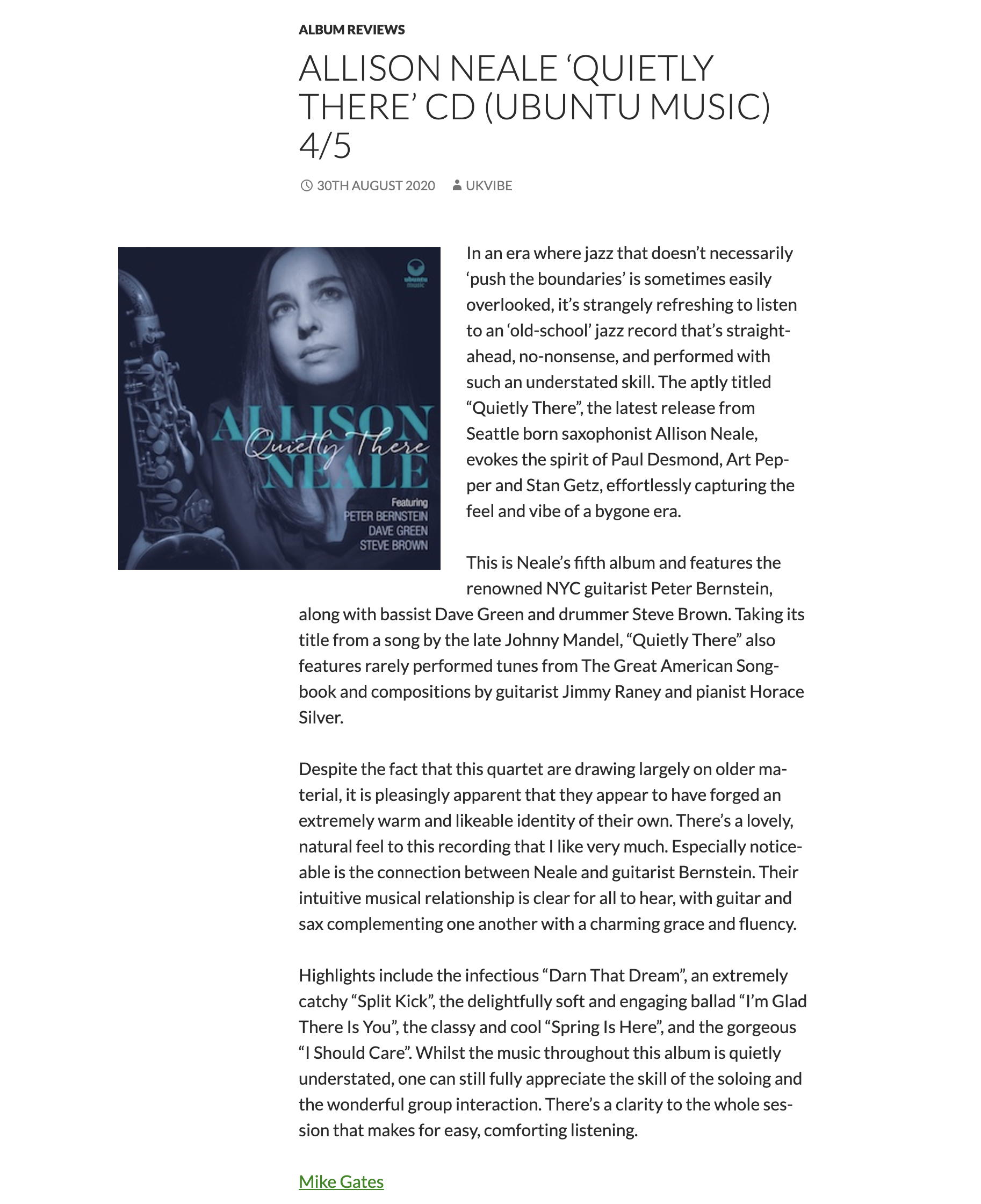Song Bar writes, “serene and sophisticated, understated and delicate.”
REVIEW: Allison Neale 'Quietly There'
The jazz Mann’s Ian Mann writes, “A very classy piece of work. The quartet perform flawlessly throughout and Neale has absorbed her influences to develop a cool alto sound that is very much her own.”
“This is a very classy piece of work and I fully understand its appeal to the still very substantial audience of mainstream jazz listeners. The quartet perform flawlessly throughout and Neale has absorbed her influences to develop a cool alto sound that is very much her own, and a cool and intelligent approach that has become something of a rarity in the current musical climate.”
—Ian Mann
REVIEW: Allison Neale 'Quietly Yours"
REVIEW: Allison Neale: Quietly There — gentle west coast swing
The Times’ Chris Pearson writes, “British reserve meets California cool.”
★★★★★ Allison Neale Sees Stars ★★★★★
Allison Neale Review: "Cool Intimacy Personified" ★★★★
The Guardian’s Dave Gelly writes, “t’s an alto saxophone sound rarely heard nowadays, cool but intimate, each phrase ending with a tiny shiver of vibrato, and no one deploys it with more delicacy or grace than Allison Neale.”
It’s an alto saxophone sound rarely heard nowadays, cool but intimate, each phrase ending with a tiny shiver of vibrato, and no one deploys it with more delicacy or grace than Allison Neale. This is her musical voice, instantly recognisable, and it remains its calm, fluent self whatever the surroundings.
On this occasion her companions are Dave Green and Steve Brown on bass and drums respectively, and the celebrated New York guitarist Peter Bernstein, who appears to have recorded with everyone. His technique is amazing, using a seamless combination of single-line and chordal playing, and his harmonic ingenuity is endless.
In fact it gets a bit wearing after a while; an occasional touch of the simple and obvious wouldn’t have gone amiss. But there’s some marvellous jazz here, notably a version of Horace Silver’s Split Kick including an ingenious close-harmony theme statement and a clever duet improvisation by saxophone and guitar. There’s an even better one in Motion, which is perhaps the most exciting of the 11 tracks. As for classic ballads, which are a Neale speciality, there’s the unmissable I’m Glad There is You, serene and elegantly expressed, as always.
Ubuntu Music Artists are All Over Sandy Brown Jazz!
SJM Gives Neale a Big Thumbs Up!
Eddie Myer writes, “it’s rare that a jazz record so unapologetically mainstream is so satisfying to listen to, and so quietly compelling that you don’t want it to end.”
Allison Neale Quietly There (Ubuntu UBU0062) Seattle-born Alison Neale has established an enviable reputation on the UK jazz scene for her thorough assimilation of the West Coast jazz style associated with Paul Desmond and Art Pepper, though her meltingly full, sweet tone makes her presence lean more towards the former than the more acerbic, bittersweet Pepper. This record matches her with an eminently sympathetic rhythm team: veteran UK bassist Dave Green is the ideal accompanist, sure and fulltoned, always on hand with the perfect supportive note choice or subtle shift of feel, and his solos are masterpieces of understated musicality, playing their part in the ensemble so tactfully yet satisfyingly that other more prolix bassists seem obtrusively show-off by comparison. Steve Brown is a frequent partner to Green on the mainstream scene and their empathy and swing are impeccable. With their flawlessly swinging backing, Neale is free to soar above, her unfailingly melodic sense and thorough engagement with the harmony of the standard based repertoire shining through in a deliberately understated, compellingly poised personality that never sounds trite even on such familiar material as Darn That Dream, delivered here in a bouncy waltz time. Completing the ensemble, New Yorker Peter Bernstein adds tasteful comping, carefully constructed solos delivered with a deliciously stringy tone, and exactly the right amount of space in all the right places: his intro to I Should Care is a small masterpiece in itself. Check out the solos on John Lewis’ 2 Degrees East 3 Degrees West for a lesson in how to deliver a swinging straight ahead blues without degenerating into cliche. Everyone is so in tune, so relaxed and yet so engaged with the material, and so in command of their technique in every aspect, from articulation to tone to the sure melodic development of every solo: it’s rare that a jazz record so unapologetically mainstream is so satisfying to listen to, and so quietly compelling that you don’t want it to end.
—Eddie Myer

































